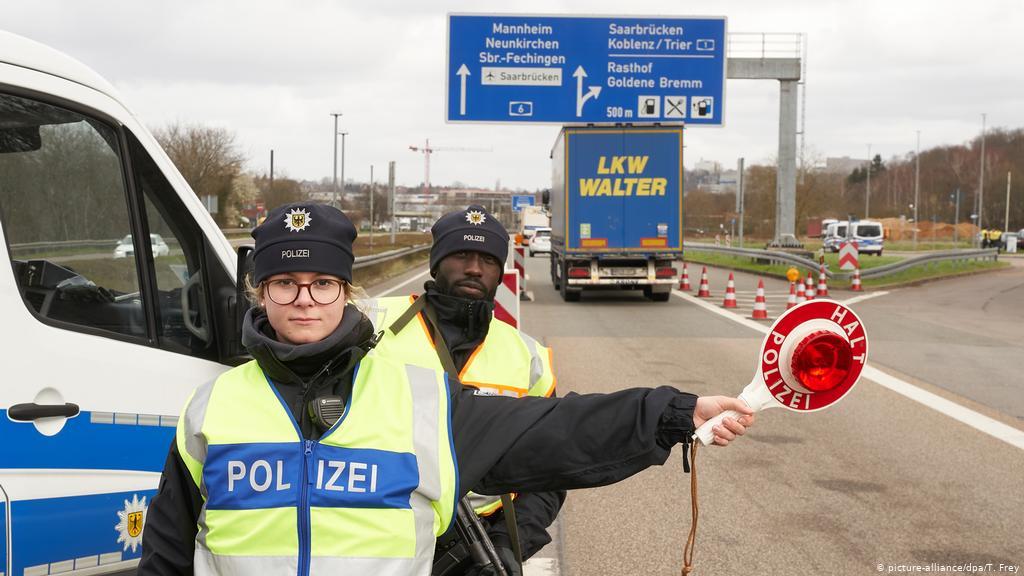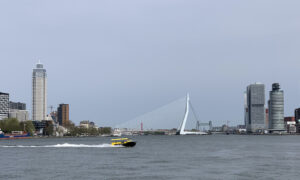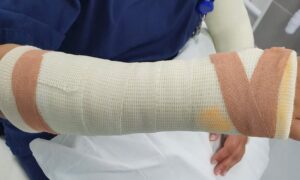(Editor’s note: As of March 2021, a majority of countries in Europe are seeing dramatic drops in infection rates and deaths. Millions of people have been vaccinated and vaccine passports are on the way in the European Union. So this is the final update for this post. We’re not saying the pandemic is over. It’s just that we’ll have fresh COVID-19 posts as we gather data about immunization rates, post pandemic business trends and travel.)
Twenty-twenty, the Year of Calamity, continues into 2021 as Austria, Germany, France, the Netherlands and other European countries are in varying degrees of lockdown, and now, travel bans.
A new strain of coronavirus has emerged in Britain, with already severe lockdowns in London and other cities predicted to become even more Draconian before vaccinations can begin in earnest. In other countries such as Austria and Belgium, the infection rates have dropped since November, but high death rates persist.
Almost a year of pandemic has shown us quickly countries such as Sweden and Germany can go from celebrated to excoriated for their approach to checking COVID-19.
We’re adding a new tool developed by Dutch graphic arts and computer specialist Jan Willem Tulp at Den Haag-based Tulp Interactive designed to help you comprehend how fast the number of cases is rising including the number of cases per minute or even per second for 150 countries. You can see Jan Willem’s data visualization tool here.
For a few weeks in June and July, it looked like the COVID-19 pandemic was over in Europe, with countries including Austria, Estonia, Greece, Ireland and Croatia reporting very low infection rates and days without a coronavirus-linked death. Then sometime in August – in a rough correlation with Europe’s vacation season – countries from Spain to Denmark started reporting a second wave with fare more cases and deaths than the early days of the pandemic in March 2020.
You can see the all the trends and graphs here on Worldometer.
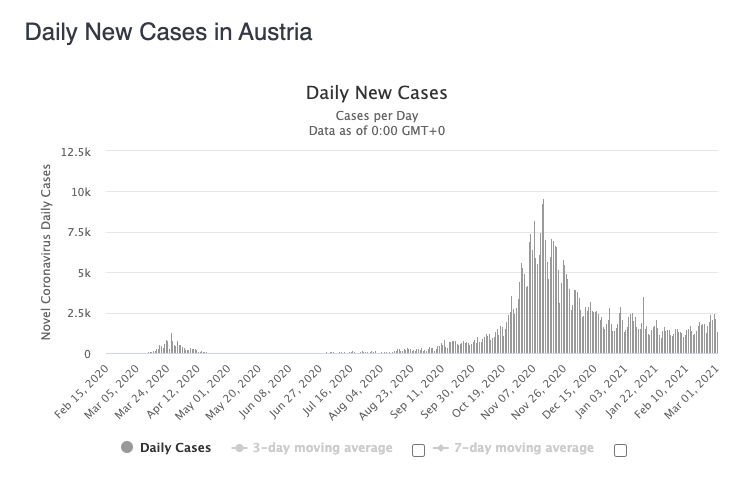
AUSTRIA
Country profile:
Austria was under a hard lockdown as of 17 November, one of the toughest in Europe, but shifted to lockdown lite effective 7 December … until 26 December, when a new, tighter lockdown went into effect. Now, the country’s third lockdown is now a lockdown light, with stores open.
Austria briefly overtook Belgium, with the highest number of new infections per million inhabitants in western Europe, according to the Financial Times COVID-19 tracker. But new cases have dropped to an average of about 2,500 per day in early March from an historic high of 9,586 new cases in 24 hours on 13 November. But 2,500 per day is still about 30 percent higher than the worst days of the first wave.
Deaths in 24 hours have declined to an average of about 20 per day as of 2 March from an historic peak of 218 on 17 December.
Austria has made headlines recently with deals to procure coronavirus vaccine outside the EU, which Austrian officials call “too slow.” The goal is to have one out of every 10 residents vaccinated by Easter, or 1 million people.
The rules:
As of 2 March, Austria is planning to loosen current pandemic rules. Cafés and restaurants with terraces will be allowed to reopen 27 March, although all customers will need proof of a negative test.
Current rules came into effect on 4 February. Hotels and restaurants are closed, but non-essential shops are back open as long as you have an FFP2 mask. BUT you have to have a negative COVID-19 test to get in salons and other businesses.
Other new rules include:
• There’s a curfew from 8 p.m. to 6 a.m.
• From 10 February, people coming any country except Australia, Finland, Greece, Iceland, New Zealand, Norway, Singapore, South Korea, and the Vatican must show a medical certificate proving a negative PCR or antigen test and commit to self-quarantine. People who don’t have negative tests are required to get tested within 24 hours after arrival.
• Only essential travel is allowed to the Tyrol region, which is a coronavirus hotspot. Police are checking to make sure people have a current negative test when leaving Tyrol and entering the rest of Austria.
You can see the official coronavirus tracking dashboard here.
As of 11 September, Kurz reintroduced mandatory face mask rules in all public spaces, supermarkets, shops, government buildings and schools, according the the Voice of America.
They remain mandatory on public transportation.
New anti-coronavirus measures including a 10 p.m. curfew in the tourist states of Tyiol, Vorarlberg and Salzburg just in time for ski season to keep skiers from congregating in clubs and bars after a day on the slopes.
There will also be mandatory face coverings on the slopes and in the gondolas.
The border:
Tourism and leisure travel a banned. As of 12 February, Germany has imposed controls on its border with Austria.
On 20 December, Austria closed its borders to travelers from the UK though Austria has refused to close its ski areas. BUT, with travel restrictions, only the Austrians are skiing. Anyone entering the country from risk areas must quarantine for 10 days.
Otherwise, you should check the Austrian Federal Ministry of Social Affairs, Health, Care and Consumer Protection website here to see if there are new restrictions as the situation is changing daily.

BELGIUM
Country profile:
In early November, the country’s public health officials said they were losing control. But as of 2 March, the number of new COVID-19 cases every 24 hours has decreased to about 10 percent of the peak on 29 October.
Belgium has the dismal distinction of having the highest rate of deaths per million of population – 1,905 as of 2 March – in the world and more than 21,500 deaths since the pandemic began. It has the fourth-highest rate of infection in Europe behind the Croatia, Estonia and the Czech Republic, with a total of 774,300 cases, or 6 percent of the population as been infected with COVID-19 as of 3 March.
Since the end of October, the infection rate has dropped from a peak of about 24,000 new cases in 24 hours on 30 October to as low as 960 on 12 January, so the second wave seems to have plateaued at an average of about 3,000 new cases every 24 hours as of 3 March/
Belgium reported a total of about 150 deaths August and about 80 in September. The situation just kept getting worse, with about 1,200 deaths in October and a peak of 345 reported on 11 November. There were about 5,000 deaths reported in November, declining to about 3,000 for December.
As of 2 March, Belgium has inoculated about 510,000 residents, or about 4 percent of the population.
Rules:
As of 1 December, Belgium has eased its coronavirus restrictions, with shops allowed to reopen though bars and restaurants will remain closed. But as of 25 January, officials enacting a non-essential travel ban that’s in effect until 1 April.
Non-medical contact professions, such as stylists, tattoo artists and massage parlors, reopened 1 March. Belgians are still required to work from home whenever possible and pandemic rules will last until coronavirus admissions drop below 75 per day.
Prime Minister Sophie Wilmès’ website is here.
Look for the rules to be updated on the official government coronavirus page here.
The borders:
Belgium is one of the countries EU officials have told to stop closing its borders.
As in France, you have to fill out a document attesting you have a legit reason to travel. You can download the English version here.
As of 25 January, Belgians returning from Britain, South America or South Africa must quarantine for 10 days and take a PCR test on the first and seventh day. Non-residents traveling to Belgium must present two negative PCR tests – one before departure and one on arrival.
On 20 December, Belgium became one of the first countries in Europe to ban travelers from the UK due to the new, more infectious strain of COVID-19. Brits are not alone. Now, as noted above, look for a non-essential travel ban.
On 14 December, Dutch PM Mark Rutte and his Belgian counterpart, Alexander de Croo had “the talk” about keeping Dutch folks from crossing the border into Belgium and crowding into shopping streets to escape the Netherlands’ shutdown that has closed stores. At Christmas.
The agreement is, there is a ban (sort of) on “fun shopping.” There are strict rules in all stores: You must shop alone, and you can stay in a store for a maximum of 30 minutes.
Of course, how do you tell Dutch shoppers from locals? Because at the borders both speak Dutch, or at least a version of Dutch.
Winter trips and journeys to red zones are strongly discouraged. Non-essential travel to and from outside EU and Schengen countries remains prohibited and all passengers arriving in Belgium by air or sea must fill in a “Public Health Passenger Locator Form.”
Belgium has launched a travel map with open countries, and countries with travel restrictions, and you can see it here. Travel to countries marked “red” is strongly discouraged. That said, when returning from a “red zone” (that would be the Netherlands next door) you must quarantine for at least a week.
On 7 August, the UK added Belgium to its list of countries British citizens are discouraged from visiting for anything other than essential travel.
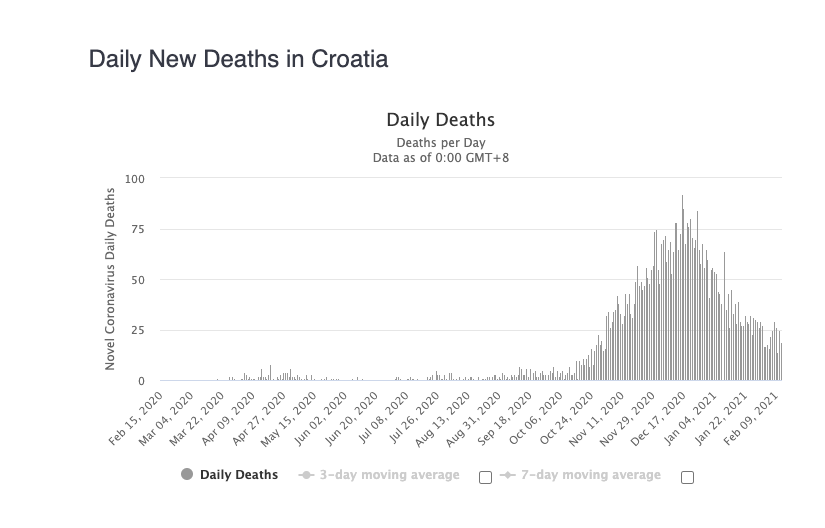
CROATIA
After a scary bad December, when daily COVID-19 infection rates and deaths were off the charts, the pandemic is once again retreating in Croatia. As of 3 March, there have been about 243,458 confirmed cases and about 5,540 deaths. In May, it appeared the pandemic was over in this Adriatic country, with Croatia escaping largely unaffected, especially compared to Italy and Spain.
But about 1 million tourists poured into the country during July and August. Unlike most countries in the EU, Croatia allowed tourist from the US and other countries, with predictable results. The European Center for Disease Control and Prevention reported that for the week of Aug. 10 to 16, there was a 174 percent increase in the rate of infections compared to the week prior.
In short, no country in Europe – not even Spain – saw cases rise so dramatically, with one out of every 58 people diagnosed with COVID-19 dying – one out of nine hospitalised in late November.
July was a tough month, with daily new cases rising steadily in a second wave, peaking at 140 on 11 July, then receding to 28 on 6 August. Then Croatia had a third, far more severe wave, with an historic peak of 4,620 new cases reported on 10 December. That’s 40 times the number of cases in 24 hours of 96 on 1 April, the peak of the first wave.
That wave has passed, with new coronavirus cases in 24 hours dropping to as low as 134 on 25 January and the number of hospitalized COVID patients dropping rapidly.
As in Austria and other countries with new coronavirus spikes, there hadn’t been a corresponding rise in deaths, with about 35 deaths in August and 80 for September. That’s changed, as well. On 16 December, the country recorded 92 deaths in 24 hours, the highest since the pandemic began. There were about 270 deaths reported in October. There were 1,000 total deaths recorded in November and about 2,200 deaths in December. Even in mid-February, the daily death rate is averaging 20 per day, about three times the rate of the worst days last April.
The good news is, Prime Minister Andrej Plenkovic has said Croatians will get vaccinated free of charge. As of mid-February, Croatia has vaccinated about 1.6 percent of the population, about average for Europe.
The rules:
Croatia is locked down through 15 February with cafés, restaurants and gyms closed. BUT, starting on the 15th, most businesses will reopen to some extent, even casinos. Cafes, bars and restaurants will be allowed to sell drinks and food to go, but terraces for guests will stay closed.
Masks are mandatory for healthcare workers, hospital visitors, drivers and passengers on public transport, customers and store employees and “employees in the hospitality business who are in contact with guests or participate in serving and preparing meals and beverages,” according to the Croatian Institute of Public Health.
Croatia has lifted its internal travel rules. Here’s the official Croatian government page.
The border:
People entering the country from the EU or EAA states must show a valid coronavirus test. Here’s the the Croatian official website.
Croatia has been on the UK’s and Slovenia’s quarantine list since 20 August.

DENMARK
Country profile:
Denmark, like Croatia, seems to have flattened the curve after the second pandemic wave. Denmark has vaccinated an estimated 9 percent of its population as of 3 March, the second-highest in Europe behind Malta.
Danish officials project all 6 million Danes will be vaccinated by 1 June.
In September, the country entered a second wave, reporting an average of about 400 new cases per day for the month. That increased exponentially to 4,508 new cases in 24 hours on 18 December, by far the most since the pandemic began. But as of early March, the infection rate has dropped sharply to about 500 new cases every 24 hours, with deaths declining as well below 10 per day.
There were a total of eight deaths reported in August and 17 in September. That rate is increasing as Denmark reports about 84 deaths recorded in October and about 90 in November. For December, there were about 350 deaths reported. January saw an historic high of 43 on 14 January, with about 520 for the month.
You can see Denmark’s COVID-19 dashboard here.
The rules:
Denmark is back open as of 1 March including many shops and schools. However, there are pandemic rules in force through 5 April and you can see them here.
Face masks are required on public transport and taxi, and are also required in airports and on flights. For full information on this and more, visit the Danish Health Authority pages.
The borders:
Denmark is developing a digital “vaccine passport” for people who have received a COVID-19 vaccine, but there’s no definite date for its introduction.
Denmark banned flights from the UK effective 20 December.
Denmark has issued a list of confusing edicts warning about travel to places like Finland, where infection rates are climbing, while stating the country will keep open its borders. Denmark added Finland to its high-risk list effective 27 November. But starting 1 December, borders are open for internationals coming from the EU/Schengen zone and the United Kingdom if the infection rate in those countries/regions is under 30 new cases per 100,000 citizens per week.
Effective 6 November, the UK banned all in-bound travel from Denmark due to fears of a coronavirus mutation among farmed minks could lead to a vaccine-proof version of the virus. Denmark has announced it will cull all 17 million minks in commercial operations.
Non-essential travel is also discouraged to to Andorra, Belgium, Czech Republic, Croatia, France, Hungary, Luxembourg, Malta, Monaco, Romania and Spain.
Here are the latest travel regulations, which are changing almost daily.
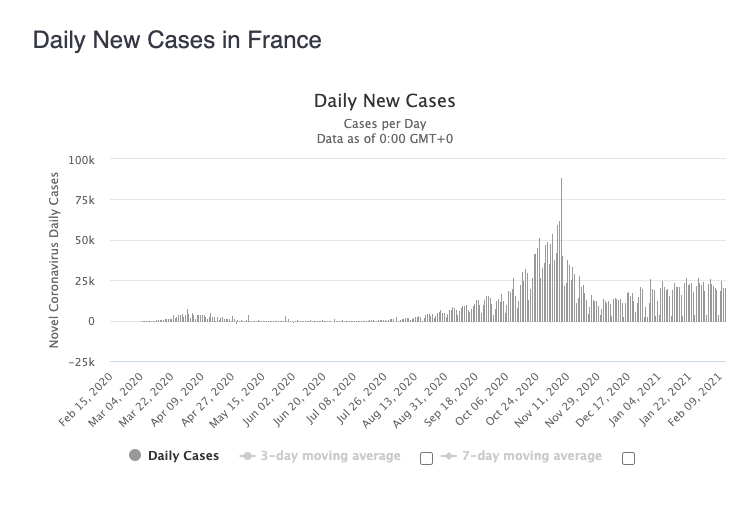
FRANCE
Country profile:
France lifted its second lockdown as of 15 December, with infection rates persistently averaging 20,000 new COVID-19 cases every 24 hours as of 3 March from as low as 4,000 in late November. Deaths have remained stubbornly at about 400 every 24 hours. But even so, France is not in lockdown as of 3 March though there are plans for a new round of pandemic measures.
France is the No. 2 European country behind the UK with the most coronavirus cases, with 3.8 million as of 2 March. The country’s death toll reached about 87,220 as of 2 March … 1,334 deaths per million of population, behind Czech Republic, Sweden, Belgium, the UK, Spain and Italy.
France reported its highest number of new cases in 24 hours – about 89,000 – on 7 November, more than 10 times the infection rate during the first peak in April, though the infection rate has plateaued. (See the chart above.)
As in other countries in Europe, daily deaths had remained relatively low compared to the first wave – about 260 in August. deaths in France spiked at 932 reported in 24 hours on 13 November.
There were about 3,500 deaths recorded in October and about 16,600 in November. There were about 10,300 deaths deaths recorded in December.
French President Emmanuel Macron has said French citizens will begin getting the COVID-19 vaccine starting at the end of December or beginning of January. But France has only inoculated 0.7 percent of its population as of 13 February, one of the lowest percentages in Europe. However, the push to get everyone inoculated is accelerating.
The Rules:
As of 2 March, the curfew is now 6 p.m. to 6 a.m. Other restrictions include big shopping centers, cinemas, theaters, museums and casinos stopped from reopening 15 December as originally planned. They were scheduled to reopen in mid-February. However, the French Assemblée Nationale ruled 21 January in favour of extending the state of health emergency through 1 June. That state of emergency gives Paris the powers to do whatever needs to be done including curfews.
Shops – though not retail malls – and services, including public libraries, are open but must close by curfew. Bars, restaurants, cinemas, theatres, museums and gyms are still closed.
Anyone out of their home during the curfew hours must have an attestation (permission form) listing the reason. You can see those reasons here. Schools remain open.
You can see all the rules here on the official coronavirus website.
The borders:
From 31 January, all but essential travel from outside of the EU is banned. Testing requirements from inside the EU will also be tightened, according to the BBC.
As of 24 January, France requires a negative PCR test 72 hours before departure for most European arrivals other than those on essential travel and cross-border workers. Anyone from another EU country – or pretty much anywhere – entering France must submit a negative coronavirus test that is no more than 72 hours old.
France banned arrivals from the UK on 20 December in an attempt to block the new COVID-19 variant. Travelers from outside the EU will have to provide a negative test before entering the country and sign a sworn statement that they will self isolate for seven days before getting another PCR test. And apparently, there are stricter requirements for people coming from inside the EU, according to Politico.
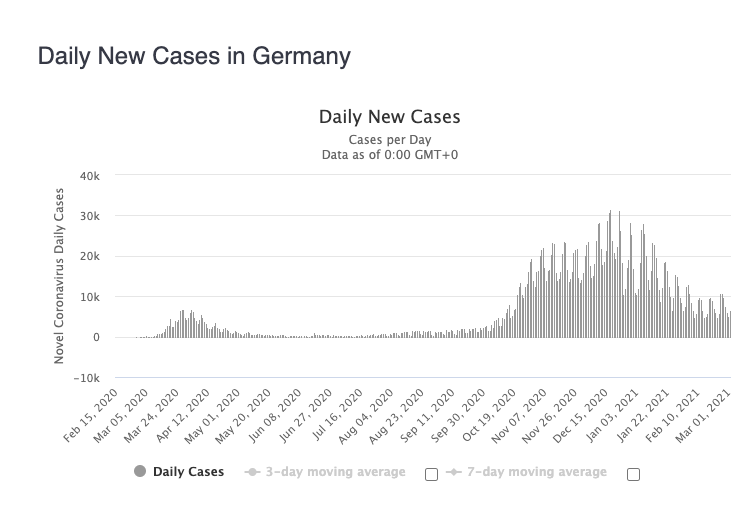
GERMANY
Country profile:
Chancellor Angela Merkel is not given to overt displays of emotion, but her early December speech rocked the Bundestag, stating that 590 deaths per day is too high a price for ignoring pandemic restrictions.
She couldn’t know that in only three weeks later, Germany would almost triple the number of deaths to a grim record of 1,244 on 29 December.
Three months later, she announced plan on 3 March to relax COVID-19 restrictions, including conditions to reopen businesses.
However, restaurants, bars and clubs are closed until at least 28 March.
Germany has the fifth largest number of coronavirus infections in Europe but one of the lower death rates 849 per million in population as of 3 March. (Compare that to Belgium at 1,905.) It has about one-third as many cases as France.
New deaths per 24 hours dipped to single digits on 20 July and new cases as low as 138 per day on 12 July, so German officials reopened almost everything including the country’s bars and restaurants and even eliminated all Schengen Area border controls. (That said, each of the 16 states have the authority to make their own local rules. You can see the federal rules here.)
German officials warned in October the number of new cases is likely to reach 20,000 per day and they were right – a record 31,553 on 18 December, with the country still averaging more than 5,000 new cases every 24 hours as of 2 March.
There were more than 90 total deaths reported in August, with at least 165 deaths in September. By comparison, there were about 900 deaths reported in October and about 4,600 in November. For December, Germany recorded about 17,000 deaths including an historic peak of 1,244 in 24 hours on 29 December. As 3 March, deaths are still averaging just over 250 per day.
Still, Germany – with Europe’s largest population and about 2.5 million cases as of 2 March – has about two-thirds of the cases reported in France and Spain, both of which have more than 3. 2 million coronavirus cases.
Germany started rolling out its BioNTech-Pfizer program last month and has vaccinated about 8 million people as of 2 March.
The rules:
Okay, from 3 March on into April, Germany will reopen incrementally, with 14-day lags, based on having 50 or fewer new cases per every 100.000 in population. Should there be three consecutive days with an incidence rate above 100 new infections per 100,000 people per week, the country goes back into lockdown..
As of 1 March, salons and other stores are reopening, though rules vary from state to state. Limited family gatherings are once again allowed but travel for Easter is discouraged.
The borders:
Germany has designated the Moselle region of eastern France as a “high risk” zone, with tougher border restrictions starting 2 March. Germany already had restrictions at border crossings with the Czech Republic and Austria.
Germany banned entry from the Tyrol region of Austria and the Czech Republic effective 14 February, according to the BBC.
Under a new travel ban, through 17 February, German residents will be able to return home, but non-German residents from several countries will be denied entry, even with a negative coronavirus test. Those countries include the UK, the Republic of Ireland, Portugal, Brazil, South Africa, Lesotho and Eswatini (Swaziland), according to the New York Times.
The new rules also forbid transportation companies — airlines, train and bus carriers, and ferry services — from bringing nearly all nonresidents into Germany with exceptions for healthcare workers and people working for humanitarian entities.
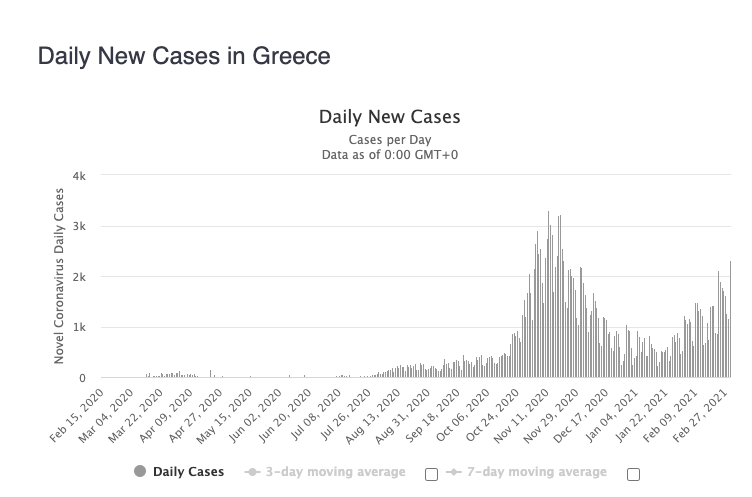
GREECE
Country profile:
Greece, like other countries in Europe, seems locked in a cycle of infection waves. But this latest wave is severe as you can see in the graphic above. Until the second wave hit Greece in October, this is another country touted early on as a model for how to deal with pandemics. Greece reported nine coronavirus deaths for the entire month of July and new daily cases had been in the low double-digits until the end of July.
This second wave wasn’t unexpected. Greek officials stated they expected as many as 5,000 “imported cases” this summer. Still, Greece has reported a peak of 3,316 cases in 24 hours on 12 November, 21 times higher than the previous peak of 156 on 21 April. But the rate of new cases every 24 hours are beginning to rise again as of 3 March, averaging about 2,000 per day. Daily new deaths are also increasing, with an average of about 30 every 24 hours as of 2 March. There were about 2,500 total deaths in December.
The rules:
Greece is back under lockdown until mid-March and the nationwide nightly curfew from 10 p.m. to 5 a.m. has been extended. You’re only allowed to leave your home for work, food shopping, visiting a doctor or exercising. Which means basically you have to stay home unless you want to go out and make money, or spend it.
There are no restrictions on how many times a day people can leave their homes, or for how long, according to the Associated Press. But everyone is required to send an SMS text message to 13033 in order to get permission to leave their homes.
Bookstores are open with customer capacity limits.
Greece has closed elementary schools, kindergartens and nurseries until the end of the month. Colleges and high schools have been closed since 9 November. A stay-at-home order was reintroduced on 7 November.
About 1 million residents had been vaccinated as of 3 March.
The borders:
Greece is putting into a place a travel corridor with Israel.
All people traveling to Greece from foreign countries will be required to have a negative PCR for COVID-19, performed up to 72 hours before they arrive. This includes air and land arrivals to Greece.
Arriving passenters must isolate themselves either at home or at a temporary residence for one week.
Here’s the official Greek travel rules site.
Greece is back on the UK’s bad list as of 14 November, with arrivals required to quarantine for 14 days.
Italy is now testing all arrivals from Greece and it’s looking like the UK could add Greece to its quarantine list.
As of August 12, travelers from Malta have to present proof of a negative molecular test (PCR) result for Covid-19 taken no more than 72 hours before.
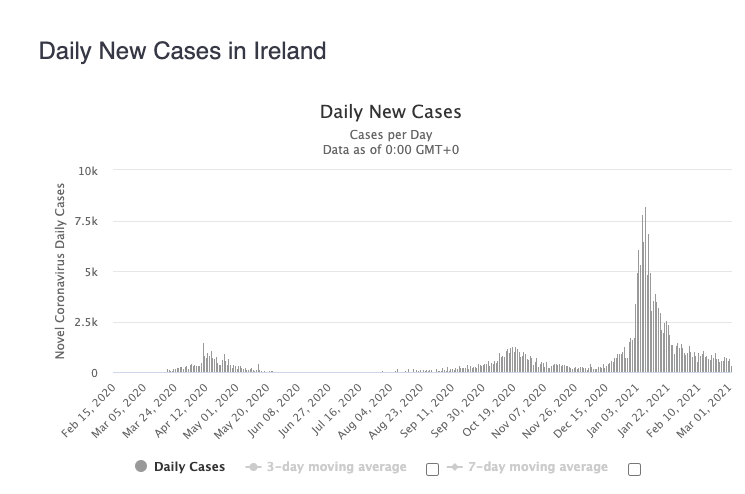
REPUBLIC OF IRELAND
Country profile:
Ireland is exiting a severe third wave, with new restrictions, with Ireland’s Level 5 lockdown extended until 5 April.
For a few weeks, Ireland replaced Denmark and Greece as Europe’s coronavirus success story. Then it all fell apart and Ireland is now in lock-down mode with total COVID-19 cases at about 209,000 as of 14 February.
Daily cases dropped to zero with zero deaths in 24 hours on 28 June from a peak of about 1,500 new cases and 220 deaths on 20 April. In December, a third massive wave started, with cases reaching 8,227 on 8 January, by far the historic high. New cases for early March have dropped dramatically, now averaging about 500 every 24 hour. But the death rate for January and February was brutal.
From 7 August to 1 October, Ireland reported only 22 deaths, all in September. There were a total of about 75 deaths recorded in October, about 107 in November and about 120 deaths in December. But for the month, new deaths every 24 hours have dropped to about 14 after more than 1,050 deaths in January.
As of 3 March, about 440,000 people have has been vaccinated in Ireland, or about 9 percent.
The rules:
Ireland is back in its third full lockdown, this one lasting until 5 April … or longer. The determiner is whether Ireland can reduce daily infections to 100 from an average of 1,100 in February.
Schools and early childcare will return on a phased basis in March.
Current restrictions include:
- No visitors in private homes or gardens unless they are providing care to children or the elderly or vulnerable, or part of a support bubble
- No social or family gatherings in any setting, with an exemption for weddings with up to six guests and funerals with up to 10 mourners
- People should stay at home except for travel for work, education or other essential reasons, or for exercise within 5 kilometers of home
- Non-essential retail and gyms are closed
Here is the official government website.
The border:
On 20 December, Ireland joined most other countries in Western Europe, banning arrivals from the United Kingdom, but it was too late. The more infectious variant jumped the North Sea.
The Irish Government announced on 11 November that passengers returning to Ireland from any red country, including Spain, can submit to a Covid PCR test after self-isolating for just five days.
The Department of Foreign Affairs and Trade advises against all non-essential travel overseas. This includes Great Britain but does not apply to Northern Ireland. It also includes all cruise ship travel. Anyone coming into the Republic, other than from Northern Ireland. This includes Irish residents. Essential supply chain services such as hauliers, pilots, and maritime staff are exempt.

ITALY
Country profile:
Italy has swung back and forth between disaster and recovery since last March. But now it’s stuck, with death rates and infection rates much higher than in the first devastating wave. (See above.) One of the biggest differences between Italy and the rest of Europe is the death rate. On a per-capita basis, Italy is 37th in the world in total COVID-19 cases, but has the fourth-highest number of deaths.
The end of April and beginning of May was a period of dramatic recovery for Italy, with infection rates and deaths dropping and recoveries rising.
But as with every country on this list, Italy is experiencing a sustained second far more severe COVID-19 wave … a wave that really hit at the beginning of October.
As of 2 March, Italy has recorded the second highest number of pandemic deaths in Europe at almost 99,000 just behind the UK. In early March, Italy is on the verge of crossing the 3 million cases mark.
In September, there was an average of 1,500 cases per day. Now Italy is averaging about 13,000 new coronavirus cases every 24 hours, with an historic peak of 41,000 on 13 November. That’s more than 600 times the rate at the worst part of the first wave in March, with healthcare workers overwhelmed.
Deaths in 24 hours peaked at 993 on 3 December and are averaging more than 350 per day as of mid-February. Italy recorded an estimated 17,000 deaths in November and about 18,000 for December.
The difference is, both the north and south of the country are affected, not just the north as in the first wave.
As of 2 March. about 4.6 million Italians have been vaccinated, or about 8 percent of the population.
The rules:
The State of Emergency has been extended through 30 April giving the government powers to set pandemic rules. They include travel restrictions and you can’t host more than two people in your home. But weirdly, Italy is loosening pandemic restrictions in some regions at the same time some health officials are calling for a total nationwide lockdown.
You can see all the rules here.
Italy’s red zones with the highest infection rate include about 16.5 million people out of a total population of 60 million. In those zones, residents can only leave home for work, healthcare essential shopping or emergencies. All non-essential shops are closed, according to the BBC.
In red zones, Italians are only allowed to move between regions for work, medical reasons and emergencies.
The border:
Italian officials announced on 15 February that the ski season is suspended. Italy also just banned flights from Brazil and anyone in the country must take a COVID-19 test.
Brits returning to the UK from Italy must self-isolate and only essential travel is recommended. If you’re going to Italy, Brits must provide evidence of a negative COVID-19 test 72 hours before travelling or get tested on arrival
COVID-19 PCR test is required within 72 hours of arrival for people coming from:
- Croatia
- Greece
- Malta
- Spain
- UK
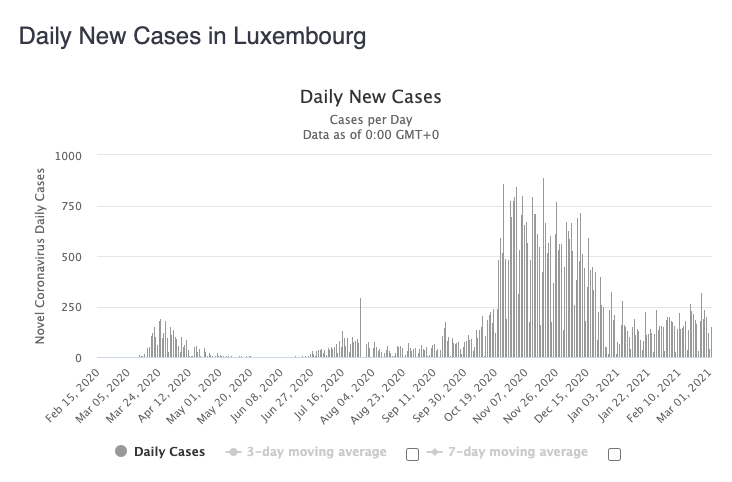
LUXEMBOURG
Country profile:
As of 3 March, the country has reported about 55,633 confirmed cases and 641 deaths in a population of only about 700,000. From mid-March into early April, Luxembourg had one of the highest infection rates in the world, but got the situation under control quickly.
Now, Luxembourg is looking at possibly a third wave of infections after a spike of 892 new coronavirus cases within a 24-hour period on 18 November, seven times the number of cases in one day compared to the first wave. As of early March, Luxembourg has seen its daily average of new cases every 24 hours rise to a peak of 324 on 24 February, though less than half the infection rate of 700 in mid-December.
But it has third highest number of coronavirus cases per 100,000 people in Europe, according to the European Centre for Disease Control and Prevention (ECDC).
There were only four total deaths in July and 10 in August. There were no coronavirus-related deaths recorded between 17 August and 1 October, but that streak ended. There were about 30 deaths recorded in October, 130 for November and about the same for December, then dropping to 70 in January.
RTL has interactive graphs documenting everything from infection rates to number of people in intensive care.
As of 3 March, Luxembourg has vaccinated 12,000 people out of its 600,000 total population, or 2 percent
Rules:
Luxembourgish officials stated on 17 October that they would not impose new measures, then promptly imposed new measures a week later, rules that were updated 26 December, extended then extended again to 14 March.
They include:
• non-essential shops that shops that do not sell food, medicine and essential items, are open with limits on the number of customers allowed inside. Restaurants and cafes remain closed, but will still be allowed to make deliveries and provide takeaway food.
• Hotels remain open and may offer room service.
• a requirement that if more than four people gather, everyone must wear masks. That’s outside the home. Inside the home, you’re only allowed to host two people.
• a curfew between 11 p.m. and 6 a.m.
• a reduction of the people allowed for gatherings to four from 10.
• cancellation of sporting events except for the semi-professional football league. Group sports with more than four are prohibited, but this rule does not apply to school activities, elite athletes and senior national teams. Fitness rooms, swimming pools, indoor climbing facilities and others are also closed, but outdoor sports facilities remain accessible. Clubs can continue to train (maximum 4 people) on football fields and tracks.
• face masks are still mandatory on all public transport and in indoor public places. Children under the age of six are exempted.
If you get caught, establishments can be fined up to 4,000 euros, while individual fines go up to 500 euros.
Here is the official government page.
The border:
Third-country nationals can’t enter Luxembourg until at least 31 March.
As of 2 January, in addition to PCR tests, rapid antigen tests will be offered free to all passengers arriving at Luxembourg airport. Everyone arriving by air must present a negative coronavirus test not older than 72 hours.
On 20 December, Luxembourg temporarily banned flights from the UK.
Luxembourg’s borders are open to European visitors, although travel from outside Europe is banned until 31 December at the earliest. It is also allowing visitors from the countries recommended by the EU.
Anyone traveling to the Grand-Duchy from most non-EU countries will have to present a negative test for Covid-19 taken no later than 48 hours before the flight.
The Netherlands and Germany have put Luxembourg back on travel blacklists. Anyone entering Germany has to provide a negative COVID-19 test or quarantine for two weeks.
A negative coronavirus test must not be more than 48 hours old. Also on the list of high-risk countries and regions are several French departments, and the Belgian region around Brussels.
Arrivals from Luxembourg to the UK must self-isolate for 14 days.

NETHERLANDS
Country profile:
Unlike their German neighbors, the Dutch just aren’t that into rules. Which turned into anti-lockdown riots all over the country in late January. But Lord knows officials tried so the health care system wouldn’t be overloaded with COVID-19 cases, so there was a lockdown that has only eased somewhat as of 3 March.
Starting in late July, the country entered a severe second wave with 13,032 cases in 24 hours on 20 December, up from as few as 36 cases in early July and almost nine times higher than the previous pandemic peak of 1,300 cases in 24 hours on 10 April. That wave has never really receded, with daily new cases still averaging 5,000 new cases every 24 hours as of 3 March, more than four times the infection rate of the first wave. The Netherlands crossed the 1 million cases mark in February.
Deaths have increased as well. The Netherlands recorded 62 deaths for the month of August. That more than doubled to about 150 total for September, then tripled to about 750 deaths reported for October. For November, there were about 1,800 reported. That trend is receding slightly, with about 1,750 deaths reported in December though there was spike of 176 on 6 January.
The Netherlands didn’t start vaccinating citizens until 6 January and the country is struggling to get sufficient stocks. Only about 1 million people out of a population of 17 million have gotten the jab as of 3 March. But the Netherlands is focused on age groups first and people 64 and 65 years old are getting their inoculations first.
The rules:
Effective thru 15 March (after an extension), the Netherlands’ curfew is from 9 p.m. to 4:30 a.m. The fine is 95 euros if you get caught out without a seriously good excuse, such as work or caring for people. Passengers starting or completing an international trip are also exempt.
Non-essential shops will reopen 3 March, but you must make an appointment for a minimum of 10 minutes to enter at least four hours ahead of your arrival. (That’s going to be interesting.) Only two shoppers are allowed in at a time per floor of retail space.
Salons, physiotherapists and massage parlors can reopen on an appointment-only basis, but sex workers are still on a forced vacation because as Prime Minister Mark Rutte noted recently, their work “requires very close contact.”
You can see the official Dutch COVID page here.
The borders:
Here are the rules for traveling to the Netherlands, which is discouraged unless it’s essential.
The Netherlands has banned all flights and ferries from the United Kingdom effective 23 January. That’s still in affect.
PM Rutte has decreed that travel abroad for all but essential reasons should be avoided up to mid-March. “The risks and uncertainties are too great,” the prime minister said. “We will also ask our neighbouring countries to make sure their people do the same.”
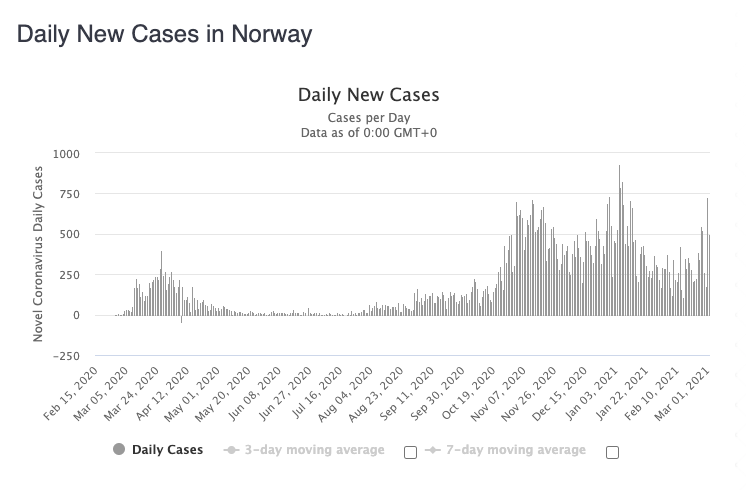
NORWAY
Country profile:
Unlike Sweden next door, Norway instituted strict coronavirus measures on 12 March, the strictest since World War II. As a result, researchers found there were no “excess deaths” – deaths above the expected number, based on previous years – in Norway during the first wave of the pandemic. During that time, 90 percent of coronavirus deaths happened among people with underlying conditions.
That was then. This is now as Norway deals with yet another severe rise in cases in early March.
Norway has recorded about 72,000 cases and about 630 deaths as of 3 March. That includes an historic high of 935 new cases recorded in 24 hours on 5 January.
There were nine deaths recorded during the month of August, 10 in September, seven in October, then increasing to 50 for November and 84 in December including an historic peak of 26 on 13 January.
With multiple COVID-19 vaccines coming on the market, Norway will make them free to citizens.
Norway can afford to because financial analysts are projecting its and that of neighboring Sweden to make the fastest post-pandemic recoveries of the advanced countries. As of 3 March, Norway has immunized about 500,000 of its 5 million residents, or about 10 per cent – one of the highest rates in Europe.
The rules:
Reuters is reporting that as of 3 February, restrictions eased in Oslo and other cities. Stores not in malls or shopping centers can reopen. Restaurants are open, although alcohol is banned.
It wasn’t until 14 August that Norwegian authorities required people to wear face masks while using public transportation in and around Olso after a second wave of infections and deaths. Sure enough, that wave plateaued.
Now masks are mandatory in Oslo.
The border:
Due to the outbreak of a more contagious variant of the coronavirus, the Norwegian government close the borders to prevent spreading this virus. Only Norwegian nationals and foreign nationals living in Norway are allowed to enter the country.

PORTUGAL
Country profile:
That was unpleasant.
At the end of January, Portugal – with the world’s highest seven-day rolling average of cases and deaths per capita – had run out of ICU beds and the German military was coming to the rescue. Which has to be a first. Average deaths every 24 hours were at the historic high.
But that peak passed quickly and as of 3 March, infection rates are down drastically, dropping to 691 on 2 March from about 16,400 new infections in 24 hours on 28 January.
Deaths dropped to 38 on 2 March from the historic high of 303 on 31 January.
After a low of 98 new cases reported on 11 May, Portugal had a severe second wave with daily confirmed new cases averaged more than 4,000 per day for December. New cases every 24 hours just peaked at almost 15,000 on 20 January in a third wave. As a result, the healthcare system was on the verge of collapse, according to Reuters. Deaths in 24 hours spiked on 22 January at 234, eight times higher than the worst day of the first wave.
There were a total of about 70 deaths in August, then 125 in September. There were about 500 deaths in October more than tripling to about 1,800 recorded in November. There were about 1,500 total deaths in December, but the death toll claimed more than 4,000 people in January.
As of 2 March, about 900,000 residents have been immunized out of 10 million, or about 0.9 percent.
The rules:
Portugal is under a state of emergency extended from Christmas to at least 16 March, with everything shut down but essential stores. Restaurants are only allowed to do carry-out. There’s a ban on travel between municipalities and public gatherings and in some cases, a 1 p.m. to 5 a.m. curfew.
Shops must close by 8 p.m. on weekdays. On weekends, shops must close at 1 p.m. though supermarkets and food shops can stay open until 5 p.m. You can see all the rules here on Portugal’s official Covid-19 page.
As early as 26 October, Portuguese officials said stricter pandemic restrictions might be coming as the number of COVID-19 patients is near record levels … and ICUs are at 50-percent capacity. (Prior to the pandemic, Portugal had the lowest number of critical-care beds in Europe, according to Reuters.)
Masks now are compulsory in the workplace.
The borders:
Portugal is off most “red” lists now and the government is lobbying the EU for a return to free travel as well as for vaccine passports.

SPAIN
Country profile:
After an impressive recovery last summer, Spain had a severe third wave of infections far exceeding rates in the early days of the pandemic as the country passed the 3.1 million cases mark. That included a spike of about 35,000 cases in 24 hours on 15 January – four times as high as the peak of the first wave back in March and April, 2020.
Deaths in January averaged about 400 per day including a spike of 591 on 26 January. February was, with a spike of 766 deaths on 9 February and approaching the worst of the first wave back in April 2020. As of 2 March, the death rate has dropped to about 200 every 24 hours.
For December, the total COVID-19 death toll dropped to 4,000, then rose over 4,000 again for January … and has already exceeded that as of 15 February. Spain has the fourth-highest number of deaths in Europe at about 70,000 behind France, Italy and the UK.
Spanish officials concede data collection is so flawed that no one really knows how many new cases and deaths are occurring daily. The situation has gotten so dire that most Christmas celebrations – some of which date back millenia – were cancelled in this heavily Roman Catholic country.
Spain has vaccinated about 4 million of its 47 million residents, or about 8.5 percent.
The rules:
A state of alert is in effect throughout the country until 9 May giving autonomous regions the power to impose nightly curfews and travel restrictions and limit gatherings based on the local infection rate. Several of those regions including Catalonia and Madrid are loosening rules, allow shopping centers and other stores. as well as outdoor dining areas, to open. El Pais in English has the details.
Curfews mostly stay in place.
Meetings are limited to four people, at this point, though there are likely to be additional restrictions announced, a situation expected to last into May. El Pais has the most complete info here.
Aragon introduced capacity limits at bars and restaurants and banned the sale of alcohol in shops between 10 p.m. and 8 a.m. At least 22 other municipalities across Spain have also have new restrictions including the entire cities of León and Palencia in Castile-León region.
Masks were already required in public where social distancing is impossible: “Using masks will be compulsory on the street, in open spaces and any closed place of public use, when it is not possible to maintain a safe distance of at least two metres,” according to new law. You can see the latest information on the Ministry of Health website here.
The borders:
Travel from outside the EU remains limited essential trips until 31 March.
On 15 February, Spanish officials announced passengers on flights and ships arriving from the United Kingdom, Brazil and South Africa are restricted to those who have resident status. People traveling from Spain to the UK must present a negative PCR test taken 72 hours before travel and isolate for 10 days, then will also have to take two more tests – on the second and eighth day of quarantine.
You can see more here on El Pais in English.
This list of risk countries changes like daily, so check before flying off to Spain.
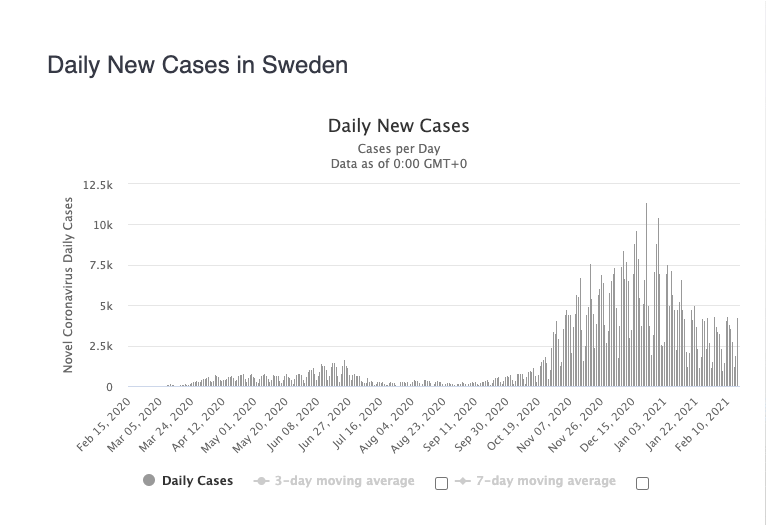
SWEDEN
Country profile
Sweden chose to protect its economy rather than its population. But as many other countries ponder exiting pandemic restrictions, Sweden finally has rules, though not a
Daily infections and deaths were declining last month, but have begun increasing again in early March with new cases every 24 hours topping 6,000 on 2 March from fewer than 200 back in summer 2020. As of 3 March, the country of 10 million had reported about 670,000 confirmed coronavirus cases and 13,000 deaths.
After a quiet summer, things turned ugly with Sweden – like every other country in Europe – entering a second COVID-19 wave, with the country reporting one of the worst rates of infection.
On 7 August, daily new cases dropped to about 41, but the average for September through October was about 1,800 new cases every 24 hours. Sweden recorded as few as 106 new cases on 13 September before the infection rate spiked to 11,387 new cases every 24 hours on 23 December.
Sweden recorded about 36 total deaths in August, 35 for September and about 36 total for October. Then deaths in November increased more than 9 times times from October to 300, with December’s toll rising to about 640.
In January, the death toll reached about 850.
One number really tells the story – Sweden has 1,270 coronavirus deaths per million inhabitants as of 3 March, compared to 114 per million in Norway, 408 per million in Denmark and 137 per million in Finland.
Late in 2020, Prime Minister Stefan Lofven said Swedish officials underestimated the virulency of the virus, with hospital ICUs now at capacity. And an increasing number of people are advocating a lockdown.
Sweden has immunized about 800,000 of its 10 million residents, or about 8 percent.
The rules:
Sweden finally has a new law that gives the government the power to institute pandemic rules such as shutting down retail and public transportation, according to Reuters. New rules include limits on the number of people in restaurants. From 1 March, restaurants and restaurants must close at 8:30 p.m.
There is an alcohol sales ban after 8 p.m. and an 8-person limit for gatherings, which means movies are closed though stores remain open with occupancy limits.
You can see all the rules here.
On 18 December, Swedish officials finally asked Swedes to wear masks on public transport at peak times. They’re also asking people to work from home and even putting restrictions on the number of people in bars and restaurants – a maximum of eight people at any table. Stockholm has reintroduced a ban on people visiting elderly care homes.
Sweden left its schools, gyms, cafes, bars, and restaurants open throughout the pandemic. Instead, the government has urged citizens to act responsibly and follow social distancing guidelines.
Sweden has opted for a calmer – and highly controversial – approach led by the state epidemiologist, Anders Tegnell. Instead of draconian lockdown, social distancing is a matter of self-regulation, according to the Guardian.
According to Bloomberg News, analysts believe that in refusing to close down businesses, the Swedish economy could have an easier time rebounding economically than countries that have shuttered businesses completely. However, Denmark’s “pigs and pills” (pharmaceuticals and agriculture) economy is in better shape than Sweden’s, with its heavy reliance on the auto sector, aviation and precision manufacturing.
Here’s a balanced look at Sweden’s successes and failures from Bloomberg.
Sweden has vaccinated about 400,000 people as of 18 February.
The borders:
Sweden and Denmark are planning to introduce a digital coronavirus vaccination certificate that would make traveling easier, according to DW.
But for the moment, travel to Sweden from people outside the EU is suspended indefinitely. People from the UK, Denmark and Norway are also banned.
The UK renewed its quarantine requirement on 6 November for anyone arriving from Sweden. Norway is now warning its citizens not to travel to Sweden.
Sweden had only had restrictions on some non-EU citizens, but that’s changing.
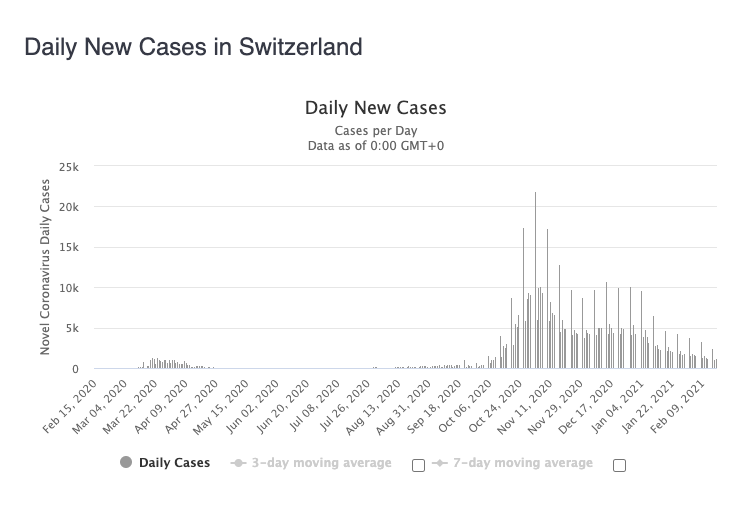
SWITZERLAND
Country profile:
Partly due to its proximity to early virus hotspots in Northern Italy, the COVID-19 pandemic had a fast and furious effect on this Alpine country. The Swiss instituted nation-wide rules relatively late in the game.
That fast-and-furious cycle repeated itself with a second, far-worse wave of infections and deaths that persisted into 2021. But as of 2 March, the infection rate has fallen below 1,100 cases per day from 22,000 in early November. Now, Switzerland is reopening.
Switzerland reported the start of a massive new wave of daily cases rising from a few hundred per day in September to 21,962 in 24 hours on 2 November with increasing hospital admissions. While the infection rate is declining as of 31 January to an average of about 2,000 daily new cases.
Swiss officials reported a dramatic rise in deaths … about 1,550 for all of November, at least 2,400 for December and about 1,900 for January.
But those to have declined to an average of less than 20 per day as of 2 March.
Switzerland has immunized about 805,000 residents as of 2 March, or about 8 percent.
The rules:
Starting 1 March:
• shops, museums and sports facilities are open again.
• Libraries and the outdoor areas of zoos – though not the indoor exhibition areas, aquariums and solariums – will reopen.
• restaurants will remain closed, cultural and sports events with spectators remain banned and a work-from-home policy will stay in effect.
• The number of people allowed at outside gathering will increase to 15 from five now.
The number of people who can be inside stores is now limited and those stores must close after 7 p.m. and stay closed on Sundays and public holidays. The federal government is leaving it to the 26 cantons to decide whether to close ski resorts, so most are still open.
Masks are mandatory in indoor public places including shops, banks, churches and cinemas. An order to wear masks on public transport has been extended to cover train stations, airports, bus and tram stops across all of Switzerland.
The borders:
From February 8, anyone flying into Switzerland – even from countries not considered to be high risk – must show a negative PCR test result that is no more than 72 hours old.
Everyone coming from high-risk countries mush quarantine for 10 days, though with a negative PRP test, that drops to seven days.
Switzerland has banned flights from the UK for the foreseeable future.
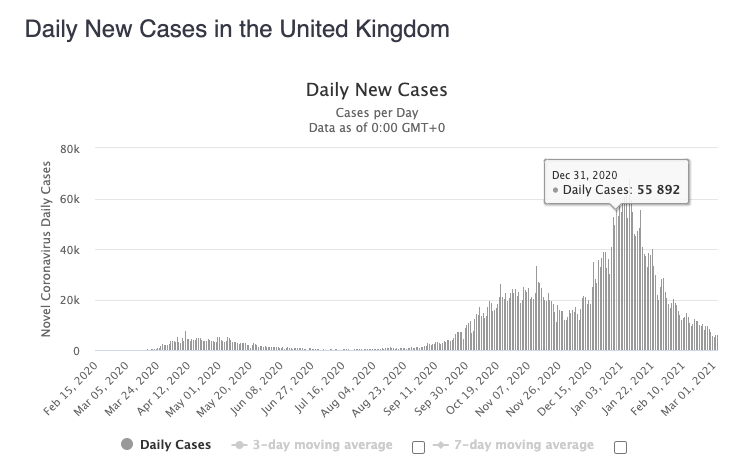
UNITED KINGDOM
Country profile:
The UK’s fortunes have taken a dramatic turn for the better, and Britain is the first in Europe to have widespread vaccination. About 20 million adults, or 30 percent of the population, has been immunized as of 4 March.
The infection rate is dropping dramatically from the January highs, but daily deaths were averaging about 800 as of 18 February, though the trend is suddenly sharply subsiding.
Everything has turned around to the point the end of the pandemic appears to be in sight. Officials were saying a third lockdown could last into the summer. That’s no longer the case.
The UK was the first country to approve Pfizer’s coronavirus vaccine, with innoculations speeding up across England, Wales and Scotland. That’s the good news.
With almost 123,000 deaths as of 3 March, UK has the highest number of deaths in Europe, passing Italy in mid-January. The UK also has Europe’s third-highest rate of death per million in population behind Belgium and the Czech Republic.
The UK’s trend lines were favorable until a second pandemic wave hit. Daily new cases averaged about 1,100 per day for August from a one-day high of almost 8,700 on 10 April, then shot up to an historic high of more than 68,000 cases in 24 hours on 8 January. For December, the infection rate was five times as high at the height of the first wave, with patients pouring into hospitals.
Deaths spiked in a second wave of infection, with well over 1,000 for July and more than 150 in August, then 430 deaths recorded in September. For all of October, the UK recorded about 2,900 COVID-19 related deaths. That increased more than four times to about 13,400 deaths recorded in total for November, and 14,500 deaths in December.
The historic high in daily deaths is 1,820, recorded on 20 January.
Criticized early in the pandemic for erratic policies, Boris Johnson has redeemed himself by ensuring the UK has sufficient supplies of vaccines and rolling out an aggressive program to get jabs to everyone.
About 20 million people have been vaccinated in the UK as of 4 March.
The rules:
The third lockdown is here, along with new rules across the UK as of 6 January. But starting 8 March, restrictions will gradually ease, with schools opening. But on 29 March, the great reopening begins, with the stay-at-home orders lifted and Brits allowed to socialize in larger groups.
In April, non-essential stores will reopen and pubs and restaurants with outdoor seating can resume service. More stuff opens in May and by 21 June basically everything will be back to normal because nearly everyone will be vaccinate. Well, that’s the plan, anyway.
You can see all the rules here on Sky News.
For the moment:
- People cannot leave their homes. Exceptions including getting essential medical needs, food shopping, helping those who can’t fend exercise and work for those who can’t work from home.
- All schools and unis are close though daycares and nurseries remain open. End-of-year exams will not take place this summer.
- Restaurants can offer food delivery, but takeaway alcohol is banned.
- Outdoor sports venues such as golf courses, tennis courts and outside gyms are close, though outdoor playgrounds are open.
- Amateur team sports are not allowed, but elite sport such as Premier League football continue to play without crowds.
The borders:
On 15 January, UK officials announced all travel corridors closed from Monday, 18 January, meaning everyone arriving by plane, train or boat must self-isolate up to 10 days through mid-February.
Also on 15 January, the UK banned for passengers arriving from destinations across South (and Central) America, Portugal, Panama and Cape Verde. You can see that order here.
All travellers to England and Scotland from overseas must test negative for coronavirus no more than 72 hours before departure before they are allowed to enter the country or face a 500 pound fine.
If you’re in the UK and trying to get to Europe, forget it. At least 40 countries have banned flights from the UK after a new, more infectious strain of COVID-19 was discovered in England.
As of 15 December, the UK will cut its quarantine period to five days from 14 if you get a COVID-19 test, which will set you back somewhere in the neighborhood of 125 pounds.


